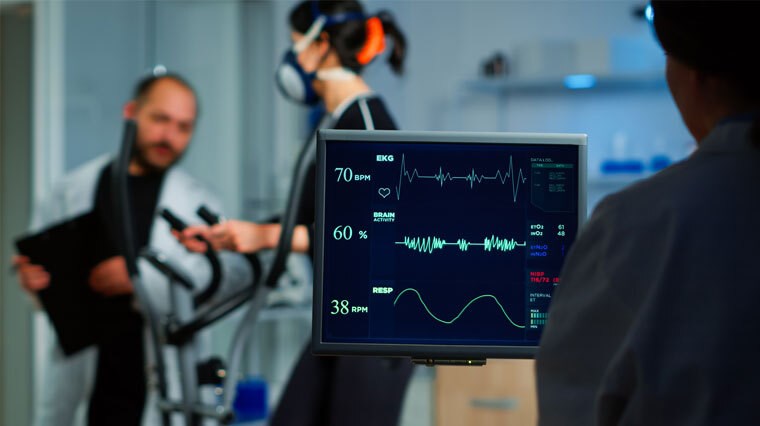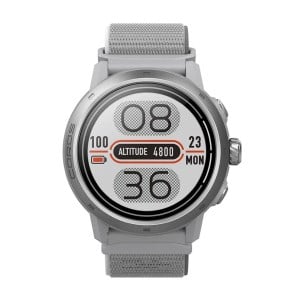A Runner’s Guide: Heart Rate Zones For Effective Training

Heart rate zones are a valuable training tool for running. No matter your running ability, from beginner runner to elite athlete, knowing your heart better can help you guide the intensity of your training.
This will allow you to create personalised running workouts that meet your specific goals - from improving performance through increasing your endurance, speed and aerobic fitness, to supporting your weight loss journey.
In this blog, we'll dive into the details of heart rate training zones, their benefits and how you can integrate them into your running plan. But to understand heart rate training zones, we'll firstly step back to the basics.
We'll discuss what your resting heart rate can tell you about your cardiovascular (heart) health and how to determine your max heart rate. This information can help you develop a heart rate training plan that aligns with your current fitness and future running aspirations.
To make heart rate training easily accessible to you, we'll also uncover the best sports watch to let your heart lead the way of your running journey.
What Is A Heart Rate?

The term heart rate (also referred to as pulse rate) refers to the number of times your heart beats per minute. Your heart is a vital organ to the healthy functioning of your circulatory system. With every contraction or beat of your heart, your blood pumps oxygen-rich and nutrient-rich blood to your lungs and muscles – supporting every cell in your body.
Your heart rate can tell you a lot about your body's response to your external training load - that is, the physical stress applied to your body such as distance and pace.
Like other muscles, your heart strengthens with training. Athletes have a lower resting heart rate compared to people with a sedentary lifestyle, as regular exercise allows the heart to adapt to an increased training load.
This means an active person’s or athlete’s heart can pump blood more efficiently – both in volume and pressure - at less effort or fewer beats when at rest.
Resting Heart Rate
Your resting heart rate is measured when your body is in a relaxed state, sitting or lying down, ideally just after you wake up in the morning prior to getting out of bed (and prior to enjoying your morning coffee as caffeine accelerates your heart rate).
During rest, your heart is pumping the minimum times required per minute. Your resting heart rate can provide insight into your cardiovascular health and overall fitness, with 60 - 100 beats per minute considered within ‘normal’ range for adults. A resting heart rate between 40 - 60 beats per minute may suggest a very fit or athletic individual.
Alongside your training background, your resting heart rate can also be influenced by other personal factors such as your age, genetics, body size, stress levels or emotional state, or external factors such as temperature.
Although your resting heart rate can be determined by hand by checking your pulse, a sports watch can take out the potential for human error for a more accurate measurement.
Heart Rate Recovery (HRR)
Your heart rate recovery refers to the decrease of heart rate (in beats per minute) following strenuous physical activity as your heart returns to its pre-workout state. In basic terms, the faster your heart rate lowers after intense activity, the healthier your cardiovascular system - corresponding to a shorter recovery time.
To calculate, it only requires two numbers. Firstly, your peak heart rate during physical activity - measured using a sports watch during the most intense phase of your workout. This is typically just before the conclusion of your workout and prior to cool down.
Secondly, your heart rate one minute following the measurement of your peak heart rate, after you’ve stopped running and are in recovery mode.
The heart rate recovery formula below allows you to find the difference between the two data points:
Peak Heart Rate – Heart Rate 1 Minute Following Peak Heart Rate = Heart Rate Recovery (in beats per minute)
E.g. If your peak heart rate during a run is 170 beats per minute (bpm) and 1 minute after you stop running your heart rate is 150 bpm, the results are as follows:
170 bpm – 150 bpm = 20 bpm
A ‘normal’ heart rate recovery time can vary from person to person. The fact that heart rate recovery time naturally decreases with age, becoming slower, should be taken into account. Your level of hydration, your sports nutrition, sleep quality and caffeine consumption can also influence your heart rate recovery time on a day-to-day basis.
A drop in 18 – 20 beats or higher after one minute of rest following an intense workout is generally considered a good heart rate recovery time, whereas a drop 12 beats or lower suggests a need to consult your doctor.
Maximum Heart Rate
Your maximum heart rate refers to the number of times your heart is capable of beating per minute when it’s pumping at its fastest – typically onset by extremely intense physical activity. Your maximum heart rate is a key value in determining heart rate training zones personalised to you, acting as a benchmark.
It’s important to remember that a higher max heart rate doesn’t necessarily correlate with improved fitness, whereas a lower resting heart rate does. From gender to genetics to your unique physiology, there are many factors at play. However, you may be able to train at your max heart rate for longer with improved fitness.
Unlike your resting heart rate which can be measured easily home with a sports watch, calculating your maximum heart rate can be challenging.
How To Determine Max Heart Rate

Age-Based Formulas
An aged-based formula can provide a rough guide of your maximum heart rate. This method to work out max heart rate is suitable for beginner to intermediate runners or non-competitive runners getting into the world of heart rate training. Advanced or elite runners on the other hand may benefit from the more accurate and personalised method of a VO2 max test discussed below.
It’s important to note these age-based formulas are not a precise method of determining your maximum heart rate, as factors such as your genetics and fitness level aren’t taken into account.
Most overestimate maximum heart rate by 5 – 10 beats per minute in women, with research studies in the past typically being based on male populations. The Gulati formula however was developed specifically with the physiology of women in mind.
These age-based formulas should be considered estimations and theoretical rather than precise to real-world training – keeping in mind there may be significant variance from your true maximum heart rate, potentially 10 – 12 beats per minute on either side, than the results may suggest.
However, these max heart rate formulas do provide a stepping stone towards knowing your heart better and making heart rate training more accessible to beginners. When the result has a decimal place, round to the nearest whole number.
Fox Formula: Simplistic Method
220 – Your Age = Maximum Heart Rate (MHR)
E.g. For a 40 year old adult:
220 – 40 = 180 beats per minute
The Fox formula has been a popular, classic method to calculate maximum heart rate in the past. Even though it has continued to be used in numerous fitness apps, it is simplistic and is not intended as a rule, only an estimation.
It does not account for gender, and is less reliable when calculating heart rate for people under the age of 30 or above the age of 40. It may deviate up to 12 beats per minute on either side of your true maximum heart rate.
Many of the following formulas are variations of the Fox formula, and can offer more precise results for different portions of the population.
Gulati Formula: Suitable for women only
206 – (0.88 × age) = Maximum Heart Rate (MHR)
E.g. For a 40 year old woman:
206 – (0.88 x 40) = 170.8 beats per minute
The Gulati formula is designed specifically for women, taking into account that they typically have a lower max heart rate than men.
Gelish Formula: Suitable for all ages, including seniors
207 – (0.7 x Your Age)
E.g. For a 40 year old adult:
207 – (0.7 x 40) = 179 beats per minute
The Gelish formula is considered more precise than the Fox formula, and takes into account heart rate changes that occur with age.
Tanaka Formula: Suitable for all ages, including seniors
208 – (0.7 x Your Age) = Maximum Heart Rate (MHR)
E.g. For a 40 year old adult:
208 – (0.7 x 40) = 180 beats per minute
The Takana formula has similar applications to the Gelish formula. The Tanaka formula is generally considered more precise than the Fox formula, and takes into account heart rate changes that occur with age. It’s estimated to have a standard error variance of approximately 7 beats per minute, which is relatively low compared to the classic Fox formula.
Hunt Formula: Suitable for active adults, including seniors
211 – (0.64 x Your Age) = Maximum Heart Rate (MHR)
E.g. For a 40 year old adult: 211 – (0.64 x 40) = 185.4 beats per minute
The Hunt formula is generally applied to men and women with an active lifestyle, including active seniors.
VO2 Max Test

A VO2 max (also referred to as maximal oxygen uptake or maximum aerobic power) test under laboratory conditions is the most accurate method of measuring your maximum heart rate and overall cardiovascular/aerobic fitness.
Under supervision, the participant runs on a treadmill while wearing a breathing mask with the intensity gradually but consistently increasing in speed or gradient/incline to the point of exhaustion.
The breathing mask allows the volume (ml) of oxygen per body weight (kg) per minute that is being inhaled and exhaled from the participant to be measured. This determines how much oxygen your body can use while exercising at maximum effort. A higher VO2 max suggests improved efficiency at transporting oxygen from the air to your active muscles – allowing you to train at a higher intensity for extended periods.
Your VO2 max has a relationship with your heart rate. As the intensity increases, your heart must work harder to pump blood around your body to support increased oxygen demands. VO2 max tests also give you access to personalised data on your lactate threshold and heart rate training zones.
VO2 max tests are generally taken by elite endurance athletes such as marathoners, as well as anyone serious about boosting athletic performance. They can be costly, however if performed regularly they can help track your training progress and adapt your training methods based on precise running metrics.
Field Test
Determining your max heart rate through a field test should only be performed by very fit individuals or advanced athletes, and only if your doctor approves. Essentially, they not only test the capacity of your heart but your mental fortitude.
Not only are they not advised for beginners, but they are usually inaccurate for beginners as most will stop before reaching their max heart rate – understandably so, because it hurts to train at this intensity. The level of mental resilience required to reach max heart rate is often developed with experience digging deep mentally, until your body is moving at the peak of its ability, such as within a competitive setting.
The field text involves simulating the VO2 max test on the treadmill or in real-world conditions – pushing your body to the absolute limit while wearing a running watch to determine your max heart rate. Indoor tests (on the treadmill) are preferred, as they remove outdoor variables (e.g. weather) – making the test more easily repeatable over the following months to track changes.
There are multiple ways of achieving this – all of which put extraordinary stress on your body. Some involve a combination of running at a tempo pace and sprint for a specific time or duration, or hill running at a progressively faster pace each time. It’s important to only attempt a field test in a well-fuelled and well-rested state - no strenuous exercise the day before!
A treadmill is the best approach both in terms of accuracy and safety to keep the test controlled – with a ramp test allowing a gradual climb of intensity and a steady rise of heart rate, rather than a sudden spike in heart rate which can be harmful.
An example of a treadmill ramp test to determine max heart rate is as follows:
- Warm up for 10 – 15 minutes
- Run on your treadmill at 0% incline, at your usual 5km pace
- Raise the incline by 2% after each 2 minute period
- Repeat step 3 until the pace is no longer sustainable – at this point you’ll be utterly exhausted and your energy will be depleted
Of course, do take safety precautions (e.g. have someone supervise, like a personal trainer to operate the treadmill) and don’t forget to wear a sports watch or heart rate monitor with chest strap during the test. The data it collects when your heart rate is at its fastest (just before you’re forced to stop) is your max heart rate.
Please don’t set out to do a field test on your own. It is important to consult your personal trainer and doctor for the best way to approach it, and to determine whether it’s a viable option for you.
What Are Heart Rate Training Zones?

Heart rate training zones are a method of monitoring your training intensity and refer to different ranges of heart beats per minute. There are 5 heart rate zones spanning from very light intensity to maximum intensity.
Your maximum heart rate is used as a benchmark to determine the heart rate ranges (in beats per minute) that correspond to each heart rate training zone. Each of the heart rate exercise zones is calculated as a percentage of your maximum heart rate.
Training in each heart rate exercise zone has different benefits allowing you to better customise your training plan to suit your running goals. When runners ask, “What’s a good average heart rate when exercising?” the answer is dependent on your goals and fitness level.
Beyond the quantifiable heart rate data itself, running heart rate zones are less about setting a specific pace – because that’ll be unique for everyone – and more based on your perception of effort. As you train over the coming weeks and months, you may discover that setting a pace that you perceived as hard in the past, now only presents a moderate difficulty.
Essentially, your heart and muscles are naturally becoming more efficient, which in turn can lower your resting heart rate. If continuous improvements in performance is your goal, it’s important to adapt your training as you progress, which may mean shifting the amount of time you spend in each training zone, potentially building on intensity or duration.
It is also valuable to diversify your running program by training at different heart rate exercise zones for a more balanced workout routine. Balance is this case doesn’t mean allocating the same time to each heart rate training zone. The time you spend in each zone should correspond with your goals and be appropriate for your fitness level.
If you're a beginner, you may consider training 10 - 15 bpm lower than the intended heart rate zone as you acclimatise to an increased training load.
A heart rate training plan could look something like this, but this is purely an example. Is important to create a running plan that is personalised to you.
- 30% - 40% of time in Zone 1
- 40% - 50% of time in Zone 2
- 10% – 15% of time in Zone 3
- 5% - 10% of time in Zone 4
- 0 - 5% of time in Zone 5 (0% until you’ve set a solid foundation of aerobic fitness training in the other zones)
Below, we discuss each heart rate zone in detail to highlight the benefits of taking a data-based approach to your training.
0: Rest: <50% of max heart rate
Activities that do not require any perceived effort, such as sitting or lying down.
Zone 1: Very Light: 50% - 60% of max heart rate
Ideal for: Warm-ups / cool down / active recovery
Heart rate zone 1 consists of the lowest intensity of movement, yet is an essential part of your training. Within this heart rate range is where your warm-ups take place to prime your body for higher intensity, and where active recovery sessions take place to gradually and safely transition to a pre-workout state after exercise.
Activities that fit within Zone 1 include stretching and leisurely walking.
Zone 2: Light: 60% - 70% of max heart rate
Ideal for: Increasing basic endurance / fat-burning
Regularly including heart rate zone 2 within your workout routine allows you to consistently build on your endurance and your aerobic (‘with oxygen’) fitness.
For most training plans, the majority of time is designated in zone 2 compared to the other heart rate zones, as not only does it have its own benefits, it also sets the foundations of performing at higher intensity efforts.
In terms of perceived effort, exercise within heart rate zone 2 should feel easy to maintain for a long period of time, such as a comfortable walking or jogging pace that allows you to have a conversation.
Heart rate zone 2 is also a fat-burning zone, supporting weight loss while being easily accessible to people of all abilities. However, if you’re on a weight loss journey it can be helpful to think of it in terms of burning calories rather than fat specifically – meaning higher intensity workouts that burn calories faster, can also can be a valuable part of your weight loss training plan.
When enjoying light exercise at longer distances, your body both uses stored fat as fuel (with oxygen essential to this metabolic process), and becomes more efficient at using stored fat for energy over time for sustainable weight loss (as long as there is a calorie deficit).
For athletes, racing within heart rate zone 2 for a period of time can help conserve glycogen (stored energy in your liver and muscles) as a quick energy source when a burst of speed is needed, rather than depleting it before the final sprint to the finish line.
Zone 3: Moderate: 70% - 80% of max heart rate
Ideal for: Increasing speed, strength and aerobic fitness
Heart rate zone 3 forms part of your speed workouts like tempo training. In terms of perceived effort, it should feel ‘comfortably hard’. When running at this pace you’ll only be able to speak in broken sentences. Lactic acid may also begin to build up in your bloodstream as the intensity increases.
Zone 3 training helps strengthen your heart and muscles to adapt to an increased training load and particularly builds on your speed. If performed consistently, you’ll be able to maintain a fast pace with less perceived effort.
Zone 4: Hard: 80% - 90% of max heart rate
Ideal for: Increasing your lactate threshold
Unlike aerobic (‘with oxygen’) exercise which is performed at lower intensities, zone 4 shifts into an anaerobic (‘without oxygen’) running heart rate zone – requiring a faster, more immediate energy source. Within zone 4, you may experience heavy breathing and only being able to speak 1-3 word answers – a pace that is sustainable at a level of ‘controlled discomfort’.
Heart rate zone 4 is typically considered a ‘race pace’ and forms a part of high intensity interval training (HIIT) workouts. Training at zone 4 can boost calorie burn even during the recovery phase.
When training at this higher intensity, your body switches from fat-burning to carb-burning – with carbs faster for your body to convert into fuel, as this process doesn’t require the presence of oxygen when energy demands rapidly increase.
These carbs are in the form of glycogen (stored energy in your liver and muscles). The process of breaking down glucose for energy by your cells increases your lactate production, a natural by-product of anaerobic energy metabolism.
Running within heart rate zone 4 may allow your body to adapt to higher concentrations of lactate in your bloodstream and trains your body to metabolise it more efficiently.
A Note On Lactate Threshold
Depending on your fitness, heart rate zone 4 may involve training at the very limits of your capacity to process lactic acid without it building up in your body faster than it can be cleared.
In terms of perceived effort, running at your lactate threshold or anaerobic threshold is equivalent to setting the fastest pace you can maintain at a steady, sustainable effort (for about an hour) without being overcome by fatigue.
Beyond this point, lactic acid builds up faster than it can be cleared, resulting in increased acidity of the muscle cells (specifically due to excess hydrogen ions). The burning sensation felt in muscles during exercise is a result of this acidity as you train beyond the lactate threshold. This acidity in turn results in muscle fatigue and impairs the ability of your muscles to contract as efficiently.
You can increase your lactate threshold by both training at your lactate threshold at longer distances, or training slightly above your lactate threshold. The benefits include being able to run at a faster pace for longer, or to run for longer without fatigue setting in.
Although zone 4 is generally considered to be the 'lactate threshold zone’, it should be noted that the heart rate zone that corresponds to your lactate threshold can vary from person to person.
- For people with a sedentary lifestyle or beginner runners, the lactate threshold may be reached when training at 55 - 65% of maximum heart rate
- For intermediate runners, the lactate threshold may be reached when training at 80-90% of your maximum heart rate (zone 4)
- For elite runners, the lactate threshold may only be reached when training as high as 90% - 95% of their maximum heart rate (zone 5)
Zone 5: Very Hard – Maximum: 90% - 100% of max heart rate
Ideal for: Advanced athletes to build sprint speed
Within zone 5, your heart rate is near or at its maximum speed and your respiratory system is under high stress. Training at heart rate zone 5 is typically done in short bursts, as this level of intensity is not sustainable for anything longer. You’re pushing your body to its absolute limits – like closing the gap between you and the finish line with a final, all-out sprint – burning up the last of your energy.
Training in zone 5 is recommended for very athletic individuals or professional athletes only that already have a strong foundation of cardiovascular and respiratory fitness.
Including a heart rate zone 5 pace as part of interval training allows the neuromuscular system of athletes to adapt and work more efficiently, developing fast-twitch muscle fibres that are responsible for building sprint speed and supporting explosive movements.
A beginner athlete is unlikely to be able to reach this level of exertion, and attempting to do so puts them at risk of heart-related and other injuries. Not only does heart rate zone 5 require a peak level of fitness, it requires a mental fortitude that is built upon and trained for over time.
After only a few minutes at heart rate zone 5, lactic acid will build up in the bloodstream, forcing athletes to stop and recover.
How To Calculate Heart Rate Zones In Beats Per Minute
To calculate the heart rate ranges in bpm for each zone, follow the formula below:
Max Heart Rate x Percentage of Max Heart Rate = Beats Per Minute
E.g. For a runner with a max heart rate of 180 beats per minute targeting to train at 70% of their max heart rate, the following would apply:
180 bpm x 70% = 126 bpm
or
180 bpm x 0.7 = 126 bpm
or
If you prefer to skip the maths, simply type "what is 70% of 180?" into Google search.
We've continued these calculations for each heart rate zone, based on a max heart rate of 180 beats per minute.
Zone 1: 50% - 60% of MHR = 90 bpm - 108 bpm
Zone 2: 60% - 70% of MHR = 108 bpm - 126 bpm
Zone 3: 70% - 80% of MHR = 126 bpm - 144 bpm
Zone 4: 80% - 90% of MHR = 144 bpm - 162 bpm
Zone 5: 90% - 100% of MHR = 162 bpm - 190 bpm
The Best Sports Watches For Tracking Your Heart Rate

Tracking your internal training load through accurate, measurable data with the use of a sports watch has given runners the ability to not only know their heart better, but to know when to wind down the pace. This ensures that training is not only effective and supports your goals, but reduces the risk of overtraining - ensuring recovery isn't just an afterthought.
Once you familiarise yourself with the effort required to exercise in each heart rate zone, you’ll become less reliant on metrics from your sports watch to guide the intensity of your running workouts. However, if you prefer to run-by-numbers or track your progress over time with accumulative heart rate data, a sports watch is an essential tool during all stages of your running program.
It’s often less about your heart rate on the day, and more about patterns or changes you see in your heart rate and perception of effort over time, that can keep you informed on your training progress.
In terms of wearable tech to guide your heart rate training, Coros multisport watches have been a stand-out option. They feature next-generation optical heart rate sensors for precise data, and feedback from customers praise them for their consistent accuracy compared to competitors.
As heart rate monitoring forms the foundations of what makes a great sports watch, it’s hard to look past Coros. From accurate heart rate data, information around recovery and further metrics can also be extrapolated – helping you develop a training and recovery plan that works for you.
The Coros Apex 2 Pro Premium Multi-Sports Watch monitors heart rate zones, tracking the intensity of your training and time spent in each zone. This is a fundamental leap in taking the guesswork out of heart rate training. The Coros Apex 2 really gets into the nitty-gritty of your running metrics – which runners love. As an extra plus, Coros watches are known for their long battery life.
Happy running!
If you liked this, you'll love:
How To Measure & Increase Training Load For Runners
A Runner's Guide To Hydration: The Sweat Rate Test

